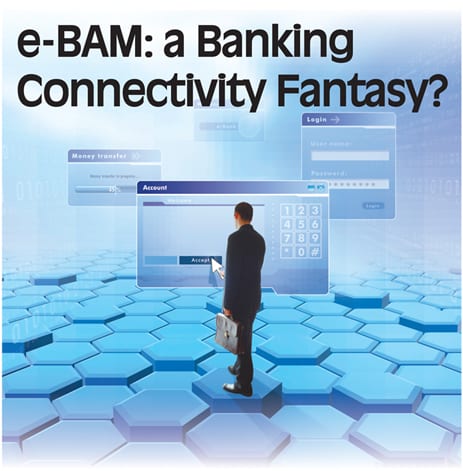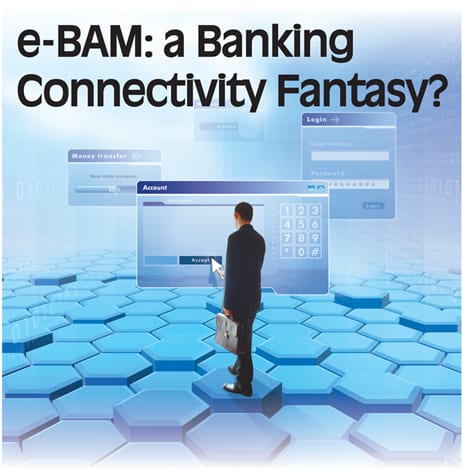After the Ballots
How the ‘year of elections’ reshaped treasury priorities
Published: January 01, 2013


e-BAM is an acronym that conceals plenty of mysteries for many treasurers. Is it a fantasy or a true message type that will really be in use in the short term? e-BAM or BAM to be more exact at the time of speaking. Let us take the mystery out of this concept by defining the outlines and the challenges of this coming era in the banking relationship.
‘e-BAM’: what lurks behind this onomatopoeic acronym? A term that is fashionable in treasury management? A buzzword doing the rounds? A word redolent of promise but that does not convince us that there is any substance behind it, at least not now? Finally, surely e-BAM is a very virtual concept, not really tangible. A treasurer’s fantasy, a mirage in the middle of the financial desert? Perhaps just wishful thinking? We should not be so negative. Nevertheless, we have not got very far with it.
For once, some treasurers seem quick(er) off the mark and especially more ready than their banks to take advantage of a new type of SWIFT message to manage the banking relationship (i.e., ‘electronic Bank Account Management’). Perhaps treasurers are getting too far ahead of the game? Surely supply falls far short of demand? A number of treasurers have raised a whole series of core, legitimate, questions.
Could the proactiveness of corporate treasurers move things forward and push the banks into offering more? By pushing the banks to offer more, they might make things happen faster. Some eBAM pioneers have anyway already gone down that road, and plan to spur the banks into action.
Aside from being a fashion item or a somewhat innovative concept, eBAM would not seem to be the most exciting and sexiest subject that treasurers could come across. Who, however, would dare say that managing the banking relationship is not worthwhile, or that it is simple, easy, carefree and most of all free of risk. No one, obviously!
It is one of the areas of improvement identified by many treasurers anxious about their procedures and internal controls. Buzzword or fuzz? That is indeed the question that you expect us to answer, to convince you that sometimes you have to act to move things on, without waiting for the banks to serve them up to you on a platter. Treasurers need to contribute to shaping the future of eBAM, rather than submitting to it passively sooner or later when the banks are ready. Many of us have so many other things on our plates that e-BAM has been relegated to the back burner. Worthwhile, helpful, but unfortunately often not considered a priority for the treasurer’s job, eBAM has not kept treasurers awake at night (and with a few exceptions they don’t sleep that well).[[[PAGE]]]
However, managing bank accounts is no easy job. What is more, no TMS is really suited to managing bank accounts. You need proper specialist software in parallel to manage your bank accounts satisfactorily and comprehensively worldwide and amongst group subsidiaries. No treasury manager that I know would dare to suggest that with a single click he could instantly get a report giving a complete and comprehensive overview of all his bank accounts, however sophisticated his IT tools may be. Surprised? This would certainly seem incredible, but even the biggest groups are usually unable to produce reports of this type. And when the information is available, it is most often obsolete because it dates back to the last annual audit and the confirmations needed for that purpose.
Often bank information repositories are in paper format and archived here and there. At best they are scanned and held in a repository in OFFICE or equivalent software. We often lack a comprehensive overview of data on bank accounts opened and active throughout the world, and of updates in signing powers on these accounts and official signed documents and contracts. We are working with counterparties, accounts or under the terms of contracts and conditions which we cannot check or refer to. Unbelievable, isn’t it? Unreal? Impossible? Not at all! Unfortunately, this is the sad reality that an honest treasurer cannot deny.
Since there is a mismatch between supply and demand, many companies feel frustration. The most visionary treasurers or thought leaders see eBAM or more accurately BAM at this stage as a final and necessary step in improving and managing internal control procedures. e-BAM is the cherry on the cake of banking connectivity, the ultimate step in managing the relationship with banks and keeping your bank account under control, a missing piece in the treasurer’s control panel. The most realistic and forward-thinking people see BAM as an intermediate step in preparing for and implementing eBAM. eBAM is certainly progressing, but not at the speed that corporate treasurers would like or would hope for.
Since we now have an ISO 20022 XML type standard and since SWIFT has developed some 15 types of message, we may expect to see eBAM projects emerge. Unfortunately in terms of fields to be filled in, information to be provided, appendices or documents to be attached, we are far from being on the same wavelength within the world of banking. At this stage, some IT sellers do not hesitate to tell you about or even promote standardisation in banking before thinking about including their corporate clients in such projects. So presumably we are in too much of a hurry in the view of our suppliers.
It is already four years since the eBAM machinery was launched. However, its huge inertia and its diesel engine make it hard for it to reach cruising speed. Some companies have volunteered themselves as guinea-pigs to develop the concept and implement it in practice. We should be grateful to them because they will make it possible to shape the system and let eBAM attain its maximum speed sooner or later. At this stage, eBAM is still a project and a worthy concept, of great interest and full of promise. Perhaps some of these things could be realised in the next few months. At the same time, SWIFT products such as the 3SKey are being developed, as are IDENTRUST type solutions for identifying who is involved in a deal and providing assurance on the quality of the counterparties with which we are dealing or with which we are exchanging documents or protocols.
eBAM will only be worthwhile if it covers all banks with which we work, with no exceptions. Nobody wants mono-bank or proprietary solutions. All of us are seeking single, overall and multi-bank solutions. SWIFT is not being slow about ‘selling’ its solution and its messages. The eBAM Central Utility (E-CU), a SWIFT portal, can also be used to promote and build or establish relationships between banks and corporates. For example, having a portal that tells you exactly what you need to open a bank account in Greece or India, and the standard documentation to attach, is an excellent idea for promoting this information and details requirement (failing true standardisation). So initiatives can come from all sides. The E-CU should become operational in mid-2013. Banks such as Citi, J.P. Morgan and BNY Mellon and corporates including Intel, British Telecom and General Electric have agreed to be guinea-pigs. SWIFT’s E-CU database should act as a catalyst for speeding up implementation of e-BAM.
Often there remains the question of knowing whether you want to be proactive and play a pioneering role or cautiously and patiently wait for others to do it for you and experiment in your place. It is up to everyone to choose their own option and decide where and when to adopt e-BAM, because at the end of the day it is only a question of time. We think that reducing such a project to opening and closing bank accounts electronically (in time, in the e-BAM version) would be of only limited interest. By contrast, a project involving setting up a repository (electronic/virtual) for information and documents relating to bank accounts, which would need to be comprehensive and systematic, in addition to access to these types of secure, formatted and standardised messages (existing or to be created) would streamline and automate internal procedures. Such a project would then be of extreme interest. Strengthening internal controls is and always will be a fundamental priority for all treasurers. For some companies, accessibility and compatibility with SWIFT e-BAM will also be the means of selecting and picking its bank partners. In short, this will be discrimination through technology. Technology will provide the required speed, security and standardisation.[[[PAGE]]]
With e-BAM we will not have to worry about finding out what we do, or do not, need to provide. These changes in local legislation and regulations ‘pollute’ bank account management and make it more complicated. Combatting money laundering and tax evasion make these account opening procedures more tricky as time goes by. In principle a bank, just like a mobile phone operator, hates losing customers and closing accounts, and fights as hard as it can to prevent closure. With e-BAM, closing an account will be easier and more routine.

Some treasury associations have worked on standardising contracts and documentation. But the fragmentation and the local legal aspect complicate the task. The environmental aspect and the cost would appear to be minor in choosing to move to e-BAM type messages. However, we should not lose sight of them. In the future e-BAM will also make it possible to send year-end audit circularisation requests and receive confirmations quickly and securely rather than by mail, fax or e-mail. If e-BAM makes only that possible, it would still be a solution to a problem shared by all treasurers generally.
e-BAM is also ‘paperless’ with no physical object being sent. It is thus clearly more eco-friendly and less expensive than sending things by mail. SWIFT messaging is better than an acknowledgement of receipt at the end of the day. The role of proactive treasurers in e-BAM is and will be helping banks to evolve and adapt. They too will be winners (surely more so than non-financial companies) when they adopt e-BAM. Managing bank documentation is extremely demanding and expensive. The pioneers will shape the process to their needs. This is a considerable advantage when you are involved in such innovative projects and in unknown territory. Some of those who are hanging back suggest that so long as we are in BAM mode they will not change and prefer to wait for the e-BAM version. This a possible approach, but not a very courageous or creative one.
Aside from the ‘fashion’ or ‘trendy’ aspect, e-BAM promises many advances and true ‘plus points’ in managing the banking relationship. It will give a complete and unobstructed view from the treasurer’s control tower, a view that today is often lacking on bank accounts. Replacing ink by a digital signature and being sure that the counterparty has indeed received what it needed is a key objective. So far we are only seeing the first signs of e-BAM, but the show is on the road and even though it may be going slowly, is on the way to better management of the banking relationship; there is no doubt about that.
